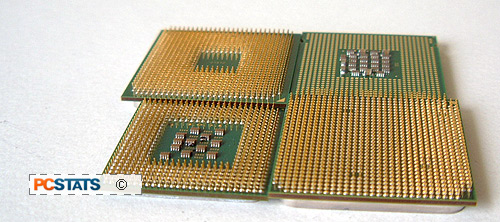Cooling has always been the one major area where Intel processors were always
considered to be far superior to AMD's offerings... remember the days of
AthlonXP's going up in smoke? While the Socket 775 Pentium 4 heatsink
architecture offers more room to grow, allows for larger heatsinks to be
installed, and a bit more scalable in the long run, AMD's not totally out of
step either.
AMD has dramatically improved the shape, size and quality of heatsinks
that it uses to keep Athlon64 processors running cool and quietly. With
the de-emphasis of OEM processors, the company has better control over the
retail heatsinks that come bundled with its Athlon64 processors, and hence the end
user experience. So far, this generation of 'K8' heatsinks have been quiet running, and
well designed so temperatures remain at acceptable levels.
To make things easier
for the end user, heatsinks can be installed in any direction without
damaging the processor. Back in the days of the socket A Athlon and AthlonXP CPU, if the heatsink was
installed in the wrong direction you'd end up with a dead chip in under 4
seconds. In the unlikely event that the heatsink fan fails nowadays, that
little tiny Athlon64 processor below will not cook itself to death.
All
current AMD processors employ thermal throttling which lowers the speed of the
processor automatically should the CPU temperature rise too high.
On the
whole, AMD and Intel are pretty
even in thermal loads this year. From the consumers point of view it makes no
difference if one processor or the other is used as both will operate reliably
and quietly.
 Step 3: Navigating Between DDR and DDR-2
Step 3: Navigating Between DDR and DDR-2
Here's a little secret, on the whole DDR-2 RAM has been
a bit of bust. Touted as the memory of the future, able to leap small buildings
in a single bound for everything from videocards to motherboards.
It promised a lot
and delivered little in the real world. Yet since the entire computer industry is shifting towards
DDR-2 RAM, we're all resigned to the fact that it's here to stay until FB-DIMM and
DDR-3 RAM break out in 2007/2008.
Of
course DDR-2 memory isn't all bad, it offers a greater level of
bandwidth between memory and processor, and that's a good thing. It's just
that single-core Intel systems (the current largest segment consuming DDR-2
RAM) aren't very inspiring, and the wonderfully low timings associated with
DDR memory have been cast aside for a pointless frequency game.
There's a difference between PC2-6400 with high lanencies, and
PC2-6400 with low latencies when it comes
the benchmarks, and
so far the latter has been sadly overlooked for far too
long.
By
the end of May, AMD's Socket AM2 Athlon64 processor will be
running along on DDR-2. The socket AM2 Athlon64 isn't expected to demand a ton of
bandwidth from the get-go, but rather benefit more from DDR-2 memory with tighter CAS latency timings.
Unfortunately at the moment these types of parts are missing from the DDR2 memory
equation so it's hard to offer commentary on where this will all be
headed.
It's very likely that initial Socket AM2 Athlon64's will perform no better,
or no worse than equivalently paced Socket 939 counterparts. Between now and then, perhaps AMD will
have tweaked the memory controller to utilize more memory bandwidth, or DDR-2 memory
latencies will have dropped somewhat. Like you, I'm still waiting to
see.
The saga isn't yet written,
and pre-release glimpses of Socket AM2 performance by way of Engineering
Sample CPUs are only telling half the story. It will be interesting to see what
happens, but certainly the prevalence of DDR-2 RAM is unrelenting.
